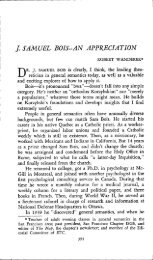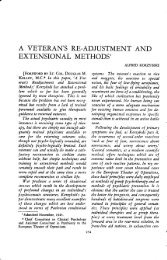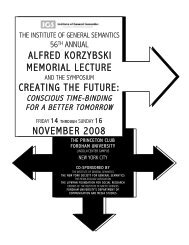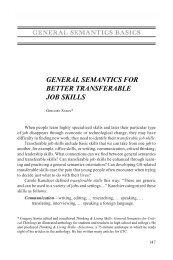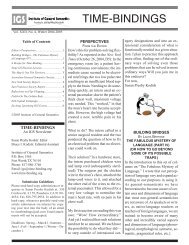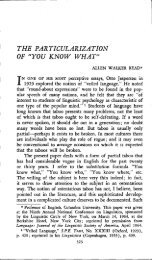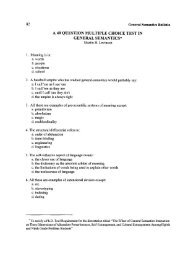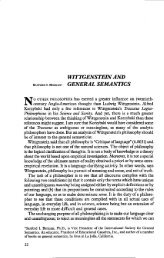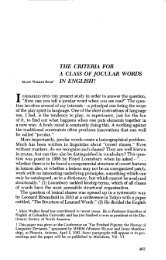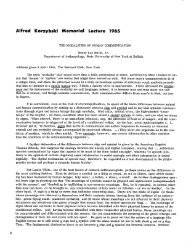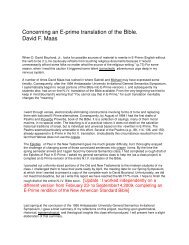EPISTEMICS - The Institute of General Semantics
EPISTEMICS - The Institute of General Semantics
EPISTEMICS - The Institute of General Semantics
You also want an ePaper? Increase the reach of your titles
YUMPU automatically turns print PDFs into web optimized ePapers that Google loves.
<strong>EPISTEMICS</strong>:<br />
A Time-Binding Emergent<br />
from <strong>General</strong> <strong>Semantics</strong><br />
J . SAMUEL BOIS °<br />
In July 1949 we had the third conference on general<br />
semantics at the University <strong>of</strong> Denver . It was the last<br />
one Korzybski attended . I remember distinctly that, in<br />
my address at the final banquet, I called him a prophet .<br />
As the term `prophet' came out <strong>of</strong> my mouth, I was surprized<br />
that this word was the only one I could pick out<br />
<strong>of</strong> my vocabulary to express what he meant to me . I<br />
habitually felt good listening to him, not only because <strong>of</strong><br />
what he said, but mostly because <strong>of</strong> the self-assurance<br />
he was oozing out in his speech and in his general demeanor<br />
.<br />
Years later I found in L . L . Whyte's <strong>The</strong> Next Development<br />
<strong>of</strong> Man a passage that helped me make sense<br />
<strong>of</strong> that reaction <strong>of</strong> mine, a reaction that has subsisted<br />
and even increased ever since . "Specially placed individuals<br />
have continuously made correct anticipations <strong>of</strong><br />
the future which could be recognized by others . Amidst<br />
the clamor <strong>of</strong> conflicting views the reliable voices can<br />
<strong>of</strong>ten be recognized by their unhesitating assurance . . . .<br />
<strong>The</strong> attention <strong>of</strong> the many is held by any conviction<br />
which facilitates their developing tendencies ; they are<br />
fascinated by any principle that <strong>of</strong>fers relaxation <strong>of</strong><br />
° Viewpoints <strong>Institute</strong>, Los Angeles .<br />
This paper was presented at a meeting organized by the New York<br />
State School Psychologists at Arden House on January 15, 1971 .<br />
1 7 7
ETC . : A REVIEW OF GENERAL SEMANTICS VOL . XXVIII, NO . 2<br />
F<br />
some general tension within a new form <strong>of</strong> life . It is<br />
because the ways <strong>of</strong> history have been well and truly<br />
paved by prophecy that the peoples move on .Ip. 214] ."<br />
Korzybski saw time-binding as the form <strong>of</strong> human<br />
energy that brings about the emergence <strong>of</strong> new disciplines<br />
. On this fiftieth anniversary <strong>of</strong> his functional definition<br />
<strong>of</strong> man as a time-binding class <strong>of</strong> life, I present<br />
epistemics as one <strong>of</strong> the developments he anticipated .<br />
oR cEwrURms the picture that Western Man had <strong>of</strong> the<br />
world was spread on a triptych . <strong>The</strong> first panel represented<br />
the realm <strong>of</strong> Matter ; the second, the realm <strong>of</strong> Life ;<br />
and third, the realm <strong>of</strong> Mind . Matter, life, and mind were<br />
the basic categories <strong>of</strong> empirical knowledge . Those three<br />
groups <strong>of</strong> phenomena, or natures as they were called, were<br />
utterly unlike one another; their differences were ultimate ;<br />
no bridge <strong>of</strong> thought could link one to another, except in<br />
abstract metaphysics .<br />
It was generally accepted as a fact that this tripartite<br />
universe had come into existence 4,004 years before Christ,<br />
during a most eventful week that God had devoted to the<br />
work <strong>of</strong> Creation. <strong>The</strong> sacred text read : "God saw everything<br />
that he had made, and behold, it was very good . On<br />
the seventh day God finished his work which he had done,<br />
and he rested ." Since then, the world had remained identical<br />
with itself . Whatever changes were recorded in history<br />
had brought none but superficial modifications <strong>of</strong> the<br />
permanent nature <strong>of</strong> things, plants, animals, and men .<br />
<strong>The</strong> triptych had no time depth prior to the week <strong>of</strong><br />
creation . Time itself had come into existence in the same<br />
week. Before its clock began measuring days, months, and<br />
years, there was eternity with God and his angels, good<br />
and bad, the world <strong>of</strong> the supernatural known by revelation<br />
and theology . Compenetrating the world <strong>of</strong> matter,<br />
life, and mind, there was a misty and mysterious world <strong>of</strong><br />
the preternatural known in the sciences <strong>of</strong> the occult and<br />
17 8
JUNE 1971<br />
<strong>EPISTEMICS</strong><br />
contacted by the arts <strong>of</strong> magic -the world <strong>of</strong> ghosts,<br />
gremlins, goblins, elves, leprechauns, sylphids, werewolves,<br />
and such .<br />
By the beginning <strong>of</strong> the nineteenth century this static<br />
picture <strong>of</strong> the empirical universe began to grow a third<br />
dimension behind the flat frame <strong>of</strong> the triptych . First it<br />
extended for only a few centuries back <strong>of</strong> the fateful week<br />
<strong>of</strong> creation . Later it stretched out in millions and billions<br />
<strong>of</strong> years to a beginning that became lost in the mist <strong>of</strong> cosmic<br />
events . Along that time dimension, spectacular<br />
changes were found to have happened in the material<br />
composition <strong>of</strong> the earth strata and in the sequence <strong>of</strong><br />
plants and animal species . Eventually a linkage between<br />
the three panels <strong>of</strong> the triptych became imperative ; it became<br />
evident that life had emerged from matter and mind<br />
had emerged from life . <strong>The</strong> concept <strong>of</strong> creative evolution<br />
over eons <strong>of</strong> time had to replace the concept <strong>of</strong> the oneshot<br />
creation at a definite date .<br />
<strong>The</strong> change in the general orientation <strong>of</strong> scientific<br />
thought came slowly, almost insidiously, until a book entitled<br />
<strong>The</strong> Origin <strong>of</strong> Species came out in 1859 . Its author,<br />
Charles Darwin, was a natural scientist, as they called<br />
them in those days . He dealt with the second panel <strong>of</strong> the<br />
triptych - that <strong>of</strong> life - and he contradicted the then prevalent<br />
belief in the fixity <strong>of</strong> plant and animal species . <strong>The</strong><br />
world <strong>of</strong> empirical science has never been the same since .<br />
As is the case with most eventful discoveries and inventions,<br />
Charles Darwin was not alone in challenging the<br />
common sense view <strong>of</strong> the universe . He had been preceded<br />
by his grandfather Erasmus, by Linnaeus, Buffon, and de<br />
Lamarck . He was accompanied in his own generation by<br />
such men as Alfred Wallace, Charles Lyell, William<br />
Hooker, and Boucher de Perthes . As a group they gradually<br />
pushed back in time the appearance <strong>of</strong> the planet<br />
earth and <strong>of</strong> the biosphere that wraps it up with a net <strong>of</strong><br />
179
ETC . : A REVIEW OF GENERAL SEMANTICS VOL. XXVIII, NO. 2<br />
living forms . With the recent invention <strong>of</strong> chemical dating,<br />
we are now able to measure with greater accuracy the time<br />
distances that separate us from pre-historic events . <strong>The</strong><br />
whole cosmos is now seen through the concept <strong>of</strong> evolution,<br />
development, and aging . <strong>The</strong>re are young and old<br />
stars, galaxies, quasars, and pulsars classified as to the<br />
length <strong>of</strong> their duration .<br />
From the central panel <strong>of</strong> the triptych, evolution has<br />
invaded the first one - that <strong>of</strong> matter - and it has linked<br />
the first and second panels together in a postulation that<br />
gains more plausibility from year to year . Pasteur may<br />
have been right when he stated that, in our present cosmic<br />
era, living forms have to come from living forms ; but he<br />
has not proved that it had always been so in the earlier<br />
stages <strong>of</strong> cosmic development .<br />
<strong>The</strong> third panel <strong>of</strong> the triptych - that <strong>of</strong> mind - had<br />
for many years an ill-defined boundary with the second .<br />
When did homosapiens, the modern man clearly characterized<br />
by his power <strong>of</strong> symbolization, appear and become<br />
a permanent resident <strong>of</strong> this planet? Was he the<br />
same as the various hominids, tool users and tool makers,<br />
whose remains are dug out in distant parts <strong>of</strong> the globe?<br />
Was he the same as the powerfully built Neanderthal<br />
who phased out at the third interglacial? Or is he identical<br />
with the Cro-Magnon who made his entry some 37,000<br />
years ago and left the unmistakable records <strong>of</strong> his painting,<br />
engraving, and sculpturing?<br />
It seems generally agreed that this Cro-Magnon belongs<br />
to the third panel - that <strong>of</strong> the mind . Himself a product<br />
<strong>of</strong> evolution from matter and life, has he continued,<br />
as homosapiens, the ongoing process that made him what<br />
he is? Or is he in this twentieth century exactly the same<br />
as he was when he painted animals on the walls <strong>of</strong> the<br />
caves at Altamira and at Lascaux, when he buried his<br />
dead, with an apparent belief in an afterlife, in the soil <strong>of</strong><br />
1 80
JUNE 1971<br />
<strong>EPISTEMICS</strong><br />
what is now Czechoslovakia, or when he used as sacred<br />
fetishes the statuettes <strong>of</strong> fertility Venuses we find here and<br />
there?<br />
THE ANSWERS to these questions will vary according to<br />
what one takes as an adequate description <strong>of</strong> members<br />
<strong>of</strong> the human species. If they are seen as made <strong>of</strong> two mentally<br />
detachable parts, a body and a mind, the answer is<br />
that they are probably the same in body - or genetically -<br />
and possibly different in mind - or culturally. Children<br />
taken out <strong>of</strong> their cultural environment immediately after<br />
birth and reared in an entirely different milieu take on the<br />
attitudes and the manners <strong>of</strong> this milieu . Once they have<br />
reached adulthood, they are hardly distinguishable from<br />
their foster brothers and sisters .<br />
What can happen in such individual cases does not<br />
take place when a cohesive group <strong>of</strong> people from a lessdeveloped<br />
culture are transplanted into a more sophisticated<br />
milieu . A gradual process <strong>of</strong> acculturation takes<br />
place . It takes two or three in some cases, even more generations,<br />
for a cultural transformation to be achieved . <strong>The</strong><br />
larger the group transplanted in a new environment, the<br />
more laborious is the process <strong>of</strong> acculturation . <strong>The</strong>re are<br />
times when it fails utterly .<br />
From this it seems that when we change our unit <strong>of</strong><br />
observation from the individual to the group the process<br />
<strong>of</strong> acculturation becomes entirely different . When we<br />
study the psycho-social evolution <strong>of</strong> mankind as a whole,<br />
where distinct stages <strong>of</strong> culture succeed one another, we<br />
have to pass from individual psychology to cultural anthropology.<br />
We see man growing at one with an all-pervading<br />
mode <strong>of</strong> existing, <strong>of</strong> relating himself to himself and<br />
to his surroundings . This makes him different in most respects<br />
from members <strong>of</strong> other cultural groups . I introduce<br />
the idea in my recent book, Breeds o f Men,2 in this way :<br />
1 8 1
ETC . : A REVIEW OF GENERAL SEMANTICS VOL . XXVIII, NO . 2<br />
An Eskimo child, born on a certain day in an isolated<br />
igloo on the icy waste <strong>of</strong> the Arctic, enters a world<br />
very different from that <strong>of</strong> a city child who comes into<br />
the world on the same day in the delivery room <strong>of</strong> a<br />
modern hospital. From their first breath they will be in<br />
contact with things and people that are not alike, with<br />
a world <strong>of</strong> personal experiences that will become for<br />
each <strong>of</strong> them the only world they will ever know . In<br />
these two dissimilar worlds both will become adults and<br />
function in two groups <strong>of</strong> fellow-humans that have very<br />
little in common . Eventully each will die, uniquely affected<br />
by differing degrees <strong>of</strong> environmental health<br />
conditions. Caught in the activities <strong>of</strong> two mutually exclusive<br />
cultural theaters, they will not have known each<br />
other or exchanged any message . <strong>The</strong>y could have been<br />
born on two distant planets and not have been more<br />
separated in their conscious existence .<br />
From this pair <strong>of</strong> unmatchable specimens <strong>of</strong> our<br />
species, seen from a distance that reveals their dissimilarities<br />
in places <strong>of</strong> abode and stages <strong>of</strong> technological<br />
development. we may come closer to the people with<br />
whom we live. At the macroscopic levels <strong>of</strong> Commonsense<br />
ooservation, they have a great deal in common ;<br />
but at the microscopic and sub-microscopic levels <strong>of</strong><br />
scientific examination <strong>of</strong> their total functioning, we detect<br />
differences that are most significant .<br />
It is a world only recently -and so far incompletely<br />
- surveyed by a very limited number <strong>of</strong> pioneers<br />
that these differentiating characteristics are to be found .<br />
This world is called the world <strong>of</strong> episteme by Michel<br />
Foucault, author <strong>of</strong> a book on what he describes as "an<br />
archeology <strong>of</strong> the sciences <strong>of</strong> man." Episteme, for Foucault,<br />
is the "general system <strong>of</strong> knowing," and he notes<br />
that it is only in our day and age that attempts have<br />
been made to take an inventory <strong>of</strong> that system .<br />
This general system <strong>of</strong> knowing is not limited to thinking,<br />
teaching in schools, lecturing in public halls, writing<br />
articles in periodicals, or publishing books . It eventually<br />
materializes into instructions, organizations, and practices<br />
in business, politics, education, family life, etc . It is the<br />
18 2
JUNE 1971<br />
<strong>EPISTEMICS</strong><br />
logos, or the principle <strong>of</strong> intelligibility <strong>of</strong> the totality <strong>of</strong><br />
a civilization at a moment <strong>of</strong> history . It is what Lewis<br />
Mumford talks about when he speaks <strong>of</strong> the "megamachine,"<br />
what Charles Reich calls "Consciousness II," what<br />
Zbiginew Brezezinski describes as the "technetronic age ."<br />
It is in this world <strong>of</strong> episteme that deep-reaching disturbances<br />
occur at the present time . <strong>The</strong>y are seen as a conceptual<br />
revolution by Percy Bridgman, a conceptual metamorphosis<br />
by Lynn White, Jr ., irreversible changes by<br />
Peter Drucker, and new system-functions by Korzybski .<br />
Mutations they are indeed . <strong>The</strong>se mutations in the evolutionary<br />
sequence <strong>of</strong> cultural breeds <strong>of</strong> men are analogous<br />
to the biological mutations <strong>of</strong> the second panel,<br />
which marked the emergence <strong>of</strong> new species <strong>of</strong> plant and<br />
animal life, and are likewise analogous to the distinct geological<br />
strata that show the eras, periods, and epochs <strong>of</strong><br />
the life <strong>of</strong> the planet earth .<br />
THE STUDY <strong>of</strong> the third panel <strong>of</strong> the triptych model <strong>of</strong> the<br />
empirical world is relatively recent . In fact, the notion<br />
<strong>of</strong> evolution took a long time to bring about a change in<br />
the philosophical orientation <strong>of</strong> writers, thinkers, and<br />
teachers . Sir Charles Sherrington wrote in 1940 : 6<br />
It is perhaps more surprising that it should have<br />
dawned upon the human mind only so latterly that his<br />
planet was a place <strong>of</strong> fresh shapes and powers <strong>of</strong> life .<br />
It now gives him a new conception <strong>of</strong> his planet and <strong>of</strong><br />
his place there . <strong>The</strong> constant intrusion <strong>of</strong> each novelty<br />
into this world had escaped the notice <strong>of</strong> his forebearers<br />
<strong>of</strong> antiquity. It had not escaped them that the world<br />
shows changes . But its changes they had glimpsed as<br />
recurrent cycles <strong>of</strong> changes . A progressive change<br />
which could be shown to have produced the novel and<br />
then scrapped it, and produced the more novel and then<br />
scrapped that, and was still going in like fashion generating<br />
and trying out the novel, without halting, must be<br />
18 3
ETC. : A REVIEW OF GENERAL SEMANTICS VOL. XXVIII, NO. 2<br />
doing something which leads somewhere . That was the<br />
conception antiquity had not reached. <strong>The</strong>ir factual<br />
knowledge was not adequate to it [p . 1211 .<br />
Until a very few years ago, no one had devised a name<br />
that could give definite boundaries to the field <strong>of</strong> study<br />
that lay in the third panel <strong>of</strong> the evolutionary picture <strong>of</strong><br />
the world . It was still covered by the old static category <strong>of</strong><br />
mind, and its complexity as a process was merely guessed .<br />
In the correspondence they exchanged in 1932-33,<br />
neither Korzybski nor Bentley could agree on a term that<br />
would cover the field they were in . Korzybski had played<br />
with such terms as "humanology," "human engineering,"<br />
and "general theory <strong>of</strong> evaluation," but found them all<br />
unsatisfactory . He eventually opted for "general semantics,"<br />
and Bentley agreed, although both had serious misgivings<br />
as to its appropriateness . Later, in 1952, Bentley<br />
published an article in Science which he entitled Kennetic<br />
Inquiry,' meaning by this new word "kennetic" - from<br />
the Scottish "ken"- a combination <strong>of</strong> knowledge and<br />
power. In 1949 he had co-authored with John Dewey a<br />
book entitled Knowing and <strong>The</strong> Known, 3 where he had<br />
referred, as had Korzybski in Science and Sanity, to the<br />
epistemological aspects <strong>of</strong> their work . But all three <strong>of</strong><br />
them - Dewey, Bentley, and Korzybski - had to leave the<br />
terminological problem unsolved. Much to their chagrin<br />
no doubt, because they felt that the efficiency <strong>of</strong> a science<br />
lies in the ability <strong>of</strong> its proponents to keep its key<br />
terms steady at every stage <strong>of</strong> its procedure and in exchanges<br />
with members <strong>of</strong> other disciplines .<br />
As a consequence <strong>of</strong> this vagueness, those <strong>of</strong> us who<br />
have continued the work <strong>of</strong> Korzybski have been for years<br />
in the ridiculous situation <strong>of</strong> people who claimed that we<br />
were dealing with improved methods <strong>of</strong> communication<br />
while we were unable to give to our own discipline a<br />
name that made sense to outsiders .<br />
1 84
JUNE 1971<br />
<strong>EPISTEMICS</strong><br />
This long and painful period <strong>of</strong> confusion has come to<br />
an end with the publication <strong>of</strong> Michel Foucault's book<br />
Les Mots et les Choses, 4 which, I am informed, will soon<br />
appear in an English translation at Pantheon under the<br />
title <strong>The</strong> Order o f Things. Foucault revives Ferrier's notion<br />
<strong>of</strong> epistemology, but he gives it a broader meaning than<br />
the one we find in current literature . Instead <strong>of</strong> restricting<br />
it to a theory <strong>of</strong> intellectual knowledge, <strong>of</strong> which logic is<br />
the main part, he uses it to cover the general system <strong>of</strong><br />
knowing - feeling - behaving that constitutes the dynamic<br />
background <strong>of</strong> our ostensive behavior . This general<br />
system - properly called episteme - determines the pattern<br />
<strong>of</strong> how we speak, write, act, establish rules and practices,<br />
and set up permanent institutions. It refers to what<br />
I have called in <strong>The</strong> Art o f Awareness our structured unconscious<br />
. In a culture at a certain date, writes Foucault,<br />
there is only one episteme ; it determines the conditions<br />
that make possible any kind <strong>of</strong> knowing, whether this<br />
knowing expresses itself in a theory or is silently embodied<br />
in a practice [p . 1791 .<br />
And so, we now have three clearcut terms to describe<br />
what we are busy with . All three are implied in the tradition<br />
<strong>of</strong> general semantics .<br />
1 . Episteme, or the general systems <strong>of</strong> knowing that<br />
were dominant in our culture at different times<br />
<strong>of</strong> history. <strong>The</strong> present one has emerged from<br />
previous epistemes that go back to our Judeo-<br />
Christian, Greco-Roman origins as a civilization .<br />
Each <strong>of</strong> us has his own individual version <strong>of</strong> it in<br />
what I called elsewhere our structured unconscious<br />
. This can be described as the dynamic<br />
pattern <strong>of</strong> attitudes, habits, internalized values,<br />
modes <strong>of</strong> perceiving and thinking by which each<br />
person relates himself to the world <strong>of</strong> things and<br />
18 5
ETC. : A REVIEW OF GENERAL SEMANTICS VOL. XXVIII, NO. 2<br />
people, observes and judges their activities, and<br />
expresses himself to himself and to the world by<br />
what he thinks, says, and does .<br />
2 . Epistemology, or the science <strong>of</strong> episteme . It obtains<br />
its information from a continuous survey <strong>of</strong><br />
all the sciences <strong>of</strong> man, organizing their findings<br />
in a set <strong>of</strong> postulates and formulations that aims<br />
at being simple and teachable .<br />
3 . Epistemics, or the discipline derived from epistemology.<br />
It views the whole <strong>of</strong> humankind and<br />
each individual as organisms engaged in a process<br />
<strong>of</strong> evolution . It takes homosapiens as the<br />
only form <strong>of</strong> life that can influence the course <strong>of</strong><br />
his own evolution . It has for its objective the<br />
knowledge and the practice <strong>of</strong> the skills <strong>of</strong><br />
awareness and self-management .<br />
I<br />
N A SENSE, this is a new science and discipline . Or, better<br />
said, it is an attempt to translate into scientific terms<br />
the wisdom <strong>of</strong> the ages, including our own as the most advanced<br />
. Epistemics covers the whole range <strong>of</strong> man's activities<br />
in the arts, in science, in politics, in administrative<br />
work and business transactions, in person-to-person encounters,<br />
in family life, in education - wherever and<br />
whenever human beings are functioning .<br />
It sounds like an ambitious program, and it is ; but it<br />
is not proposed in a self-complacent or arrogant spirit . It<br />
is an endeavor to bring up to date and make more teachable<br />
the wisdom <strong>of</strong> the brightest brains and the most dedicated<br />
souls <strong>of</strong> yesterday and today .<br />
I have already stated that epistemics is in the tradition<br />
<strong>of</strong> general semantics . Both Korzybski and Bachelard, his<br />
French commentator, were aware <strong>of</strong> what the latter called<br />
"a kind <strong>of</strong> progress that is beyond all argument ." "It is," he<br />
1 86
JUNE 1971<br />
<strong>EPISTEMICS</strong><br />
continues, "the progress <strong>of</strong> science seen as a hierarchy <strong>of</strong><br />
knowledges, measured specifically along their intellectual<br />
dimension ." Elsewhere he calls these epistemes "coefficients<br />
<strong>of</strong> reality" which give each succeeding generation a<br />
better hold on the world <strong>of</strong> phenomena .<br />
In Science and Sanity, Korzybski suggests three stages<br />
<strong>of</strong> human development, characterized by their standards<br />
<strong>of</strong> evaluation : 5<br />
1 . <strong>The</strong> pre-human and primitive period <strong>of</strong> literal,<br />
general, and unrestricted identification .<br />
2 . <strong>The</strong> infantile, or Aristotelian, period <strong>of</strong> partial<br />
and restricted identification, involving the law <strong>of</strong><br />
identity and taking the nature <strong>of</strong> things as the core<br />
<strong>of</strong> knowledge.<br />
3 . <strong>The</strong> adult, or non-Aristotelian, or scientific period<br />
based on the complete elimination <strong>of</strong> identification,<br />
establishing structure as the foundation <strong>of</strong><br />
knowledge, and taking the laws <strong>of</strong> nature as the dynamics<br />
<strong>of</strong> science .<br />
I owe a great deal to these two pioneers . Had they not<br />
blazed the trail, I might never have reached the clearing<br />
that surrounds us now . My wish and hope is that someone<br />
else comes and builds in that clearing the city <strong>of</strong> knowledge<br />
<strong>of</strong> man-in-his-world .<br />
In epistemics I spread a five-point scale on the original<br />
three-stages <strong>of</strong> development described in Science and Sanity.<br />
<strong>The</strong> people whose epistemic make-up corresponds to<br />
the various periods <strong>of</strong> the cultural development <strong>of</strong> Western<br />
Man are seen as members <strong>of</strong> breeds that emerge from<br />
one another in the course <strong>of</strong> what Julian Huxley calls our<br />
psycho-social evolution .<br />
Breed-1 men are the primitives <strong>of</strong> all times . For them,<br />
what happens in the world is limited to what they experience,<br />
and the way they experience it is taken as the way it<br />
1 87
ETC . : A REVIEW OF GENERAL SEMANTICS VOL . XXVIII, NO . 2<br />
truly happens. <strong>The</strong>re are people walking the street today<br />
who still have such thought forms ; they are cultural fossils,<br />
surviving specimens <strong>of</strong> an early breed who have not<br />
undergone evolution to full humanness .<br />
Breed-2 men appeared in the small country <strong>of</strong> Hellas<br />
some 2,500 years ago . For them, language was the outward<br />
expression <strong>of</strong> the magical activity <strong>of</strong> their thought, working<br />
as a transparent envelope that surrounded them on all<br />
sides and put them in knowing contact with the world .<br />
<strong>The</strong>y survive in breed-2 men <strong>of</strong> today who have reached<br />
a high degree <strong>of</strong> self-complacent sophistication . If their<br />
pr<strong>of</strong>essional language happens to be a special language,<br />
invented and propagated by a special school <strong>of</strong> psychology,<br />
philosophy, or theology, they claim that the whole<br />
world <strong>of</strong> man is exactly what that language describes .<br />
<strong>The</strong>y are the scholarly doctrinaires, the modem schoolmen<br />
who delight in arguing .<br />
Breed-3 men came on the scene in the seventeenth<br />
century. <strong>The</strong>ir first representatives were Galileo, Newton,<br />
Bacon, Descartes, Leibnitz, and such . <strong>The</strong>y did not change<br />
the basic orientation <strong>of</strong> their predecessors <strong>of</strong> Breed-2 .<br />
From nature as the basis <strong>of</strong> objective knowledge they<br />
passed to the "laws <strong>of</strong> nature," expressed in the new language<br />
<strong>of</strong> mathematics . <strong>The</strong>ir continuators <strong>of</strong> today swear<br />
by Research with a capital R . <strong>The</strong>y believe in the magic <strong>of</strong><br />
quantity : more money for education, more firepower in<br />
Vietnam, better computerized organizations, crash programs<br />
to eliminate poverty or crime . <strong>The</strong>y use mechanical<br />
thinking as an adequate means <strong>of</strong> understanding and manipulating<br />
events and people .<br />
Breed-4 men are still few and far between . <strong>The</strong>y are<br />
just beginning to become aware <strong>of</strong> themselves as different<br />
from what their culture has made them to be . <strong>The</strong>y know<br />
more about what they are not, what they cannot do, and<br />
what should not be as it is now ; but they have less assur-<br />
1 8 8
JUNE 1971<br />
<strong>EPISTEMICS</strong><br />
ance when it comes to describing their recently mutated<br />
self and the world that is emerging from our present crisis .<br />
<strong>The</strong>y take a broad space-time view <strong>of</strong> the universe, and<br />
they are working on a new philosophy that transcends the<br />
clashing symbol-shackled epistemes .<br />
Finally, there are men <strong>of</strong> a stage-5 breed, whom I call<br />
"participants ." At this stage, episteme ceases to be mainly<br />
a "general system <strong>of</strong> knowing ;" it assumes new dimensions<br />
. It becomes the learned art <strong>of</strong> experiencing with increasing<br />
awareness <strong>of</strong> the self and the world in a joint prehension<br />
. A new life objective emerges : It is not so much<br />
to know what is and why it is what it is; it is rather to be at<br />
one - feelingly and experientially - with all processes,<br />
persons, things, and situations that are our traveling companions<br />
in the ongoing cosmos . <strong>The</strong>y live in a world where<br />
art, science, religion, and poetry are interchangeable as expressions<br />
<strong>of</strong> man's relating himself to the universe . This<br />
stage <strong>of</strong> episteme could be described as a form <strong>of</strong> existentialism<br />
blended with robust optimism .<br />
REFERENCES<br />
1 . Bentley, Arthur S. Kennetic inquiry. Science . American Society<br />
for the Advancement <strong>of</strong> Science, 1952 .<br />
2. Bois, J . Samuel. Breeds <strong>of</strong> Men . New York : Harper & Row, 1970 .<br />
3 . Dewey, John & Bentley, Arthur S . Knowing and the Known .<br />
Boston : Beacon, 1949 .<br />
4 . Foucault, Michel . Les Mots et le Choses . Paris : Gallimard, 1966 .<br />
5 . Korzybski, Alfred . Science and Sanity . Lakeville, Conn . : International<br />
Non-Aristotelian Library, 1933, 1948 .<br />
6 . Sherrington, Sir Charles . Man on his Nature . New York : Mentor,<br />
1964 .<br />
7 . Whyte, Lancelot Law . <strong>The</strong> Next Development <strong>of</strong> Man. London :<br />
Cresset, 1942 .<br />
1 8 9



